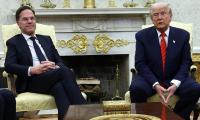On November 8, India’s policymakers carried out another major ‘surgical strike’. But this time, the strike was carried out against the Indian economy and its own people. In a blitzkrieg-like move, the Indian government outlawed Rs500 and Rs1000 banknotes as legal tender. In other words, it outlawed these denominations, which constituted almost 86 percent of the money in circulation.
The aim of the move was to strike a hard blow at corruption, tax evasion (like Pakistanis, hardly a percent of Indians pay income tax) and the informal economy. Only time will tell what the outcome is. It seems, though, that PM Modi and his advisers have severely underestimated the repercussions of this move.
Of course, large denomination bills are an increasing source of worry since they are a favourite in the informal economy, illegal transactions and terror financing. It is better to get rid of them – but there has to be some method to that.
To understand the repercussions, it is important to begin with an understanding of the functions of money. Money, generally speaking, is anything that is acceptable by two parties in an exchange. Throughout the course of human history, metals, crops, precious stones, etc, have acted as money. Money has three major properties: it is the unit of account, a store of value and a medium of exchange.
It is this third property, the medium of exchange, that is relevant to this discourse. If a government removes 86 percent of the medium of exchange, then the straightforward implication is that exchange would cease or would be severely curtailed. If exchange is severely curtailed, so is business and overall economic activity. This, in turn, affects economic growth since output declines (reflected in lower GDP growth numbers).
This link between money supply and economic output was first alluded to by David Hume in the 17th century. The 20th century saw a wholehearted acceptability of this link when Milton Friedman and Anna Schwartz demonstrated the defining impact of curtailed money supply on to the Great Depression of the 1930s.
If this logic is understandable, then there should not be many doubts that India’s GDP growth would definitely suffer a hiccup. Whether it’s severe or mild depends upon the many circumstances, especially the availability of substitute cash for the banned denominations. That is where India’s banks and people are having a problem of nightmarish proportions. Banks do not have enough cash to dispense (they are short on liquidity, to put it in technical lingo) and people cannot get their desired amount of cash (since there is a limit to withdrawals). This, not surprisingly, has resulted in long queues of people standing outside banks all over India.
And this is but one aspect of the spectre that has hit the Indian people. The repercussions range from severe loss of confidence to exacerbated poverty in India. The plight of farmers and daily wage labourers in lieu of this move is a case in point. Daily labour is finding it difficult to earn wages since the supply chain has either broken down or is under extreme stress, and there isn’t much cash available to fund their wages.
Similarly, farmers are finding it hard to buy fertilizer etc because they are severely short on cash. Sellers only accept cash and are unwilling to accept anything else, which is not surprising given that 90 percent of the transactions are conducted in cash. If they don’t get their required inputs, that could wipe out hopes of getting a good crop.
Now remember that these two groups represent a substantial portion of those living in poverty in India, or are either lying at the fringes of the poverty line. If their difficulties linger, then there is real chance that the poverty numbers would jump substantially. And if there is crop failure then India would need to import billions of tons of food, causing the Indian exchequer substantial loss.
Others too are going through tough times. And think about the level of confidence that’s taken a hit. If a government can declare cash in a person’s pocket or bank account as useless overnight, then confidence in the remaining denominations will wane. What’s the guarantee that the government will not repeat this in the future? A probable result is that people will start preferring other currencies, thus increasing their demand and inflating the nation’s import bill further.
The howler in the form of the decision to bring out Rs2000 notes is also hard to comprehend. What was the point, then, of getting rid of Rs500 and Rs1000 notes? As Professor Kaushik Basu rightly questioned, what is to stop illegal activities when there are only smaller denomination bills? It would make it difficult, but not impossible. This is also not the first time that this exercise has been carried out. Two were carried out previously, in 1946 and 1978. But there is little indication that they cured the economic ills they were meant for.
The thing is, corruption is not just about money. It’s as much a problem of ethics, morality and upbringing as of want for money. Yes, removing larger denominations would help, but will it change ethics and morality of those who indulge in this kind of behaviour? That’s very doubtful. They will always find some other source of undermining law and society (between November 8 and 9, India’s gold sellers were overwhelmed with people exchanging money for gold). As for tax payments, it’s largely a matter of trust between the citizens and their government. When governments deliver, citizens will be willing to pay their taxes.
A common fallacy here is that all the larger denomination bills are used for illegal activities. It is common knowledge that poor and unbanked families, especially in the rural side, stash away their hard-earned savings in large denomination bills. Imagine what they must be going through when they find out that their savings mean nothing. They will now have to stand in front of banks (only 27 percent of Indian villages have a bank within five kilometres), and will have to explain how they accumulated their savings. Otherwise, they won’t get anything.
PM Modi’s urge for reform this time entered into the territory of what Allan Greenspan (a foxrmer chairman of the US’s central bank) termed as ‘irrational exuberance’. This kind of move required meticulous analysis, which seems to have been absent to a large degree in this case.
It’s not just about quashing large bills and refilling banks with smaller denominations. Somebody had to take stock of the short, medium and long-term outcomes, a necessity that was not met. One could say that if the Indian voters find it difficult to forgo this episode, it might well cost Modi Sarkar the next election.
The writer is a freelance contributor.
shahid.mohmand@ gmail.com
Twitter: @ShahidMohmand79
Strong public warning systems can also help ensure quick evacuations in places prone to fires
PPPs in Pakistan's WASH sector face significant regulatory and policy challenges that hinder their effectiveness
Instead, it would have powerful chairman with three-year term, appointed at prime minister’s discretion
This is more than just education; it’s an opportunity to inspire next generation of scientists and engineers
Failure to impose credible farm tax is embedded both in Pakistan’s politics and country’s sorry economic history
However, low tax collection and narrow tax base remain unresolved issues







